Key takeaways
- Logical fallacies are subtle traps that can mislead arguments and discussions, making it crucial to recognize and understand them for clearer reasoning.
- Common fallacies like ad hominem, false dilemma, and slippery slope often arise in debates, underscoring the importance of critical thinking in evaluating claims.
- Teaching logical fallacies through real-life examples and interactive activities fosters a deeper understanding and encourages respectful dialogue among students.
- Practicing self-monitoring and asking clarifying questions helps in avoiding fallacies, ultimately improving reasoning skills and enhancing discussions.
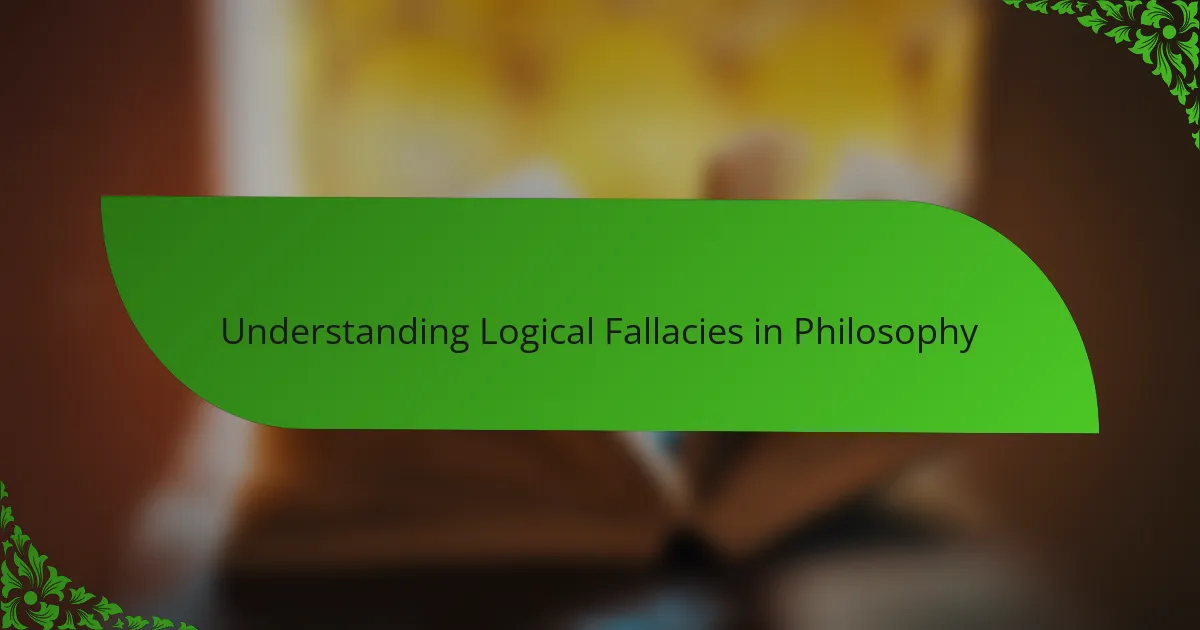
Understanding Logical Fallacies in Philosophy
When I first encountered logical fallacies in philosophy, I realized they weren’t just abstract errors but subtle traps that can derail even the strongest argument. Have you ever followed a conversation only to sense something felt off, yet couldn’t pinpoint why? That’s the power of fallacies—they mask flawed reasoning in convincing ways.
Understanding these fallacies changed how I approached debates and philosophical texts. I started to see them not as mere mistakes but as opportunities to sharpen critical thinking. It’s astonishing how recognizing a single fallacy can turn confusion into clarity.
Why do these errors persist despite centuries of study? I think it’s because human reasoning is naturally biased and emotional, making fallacies almost inevitable. This insight reminded me that philosophy isn’t about flawless logic alone, but about the continuous effort to think more clearly and fairly.
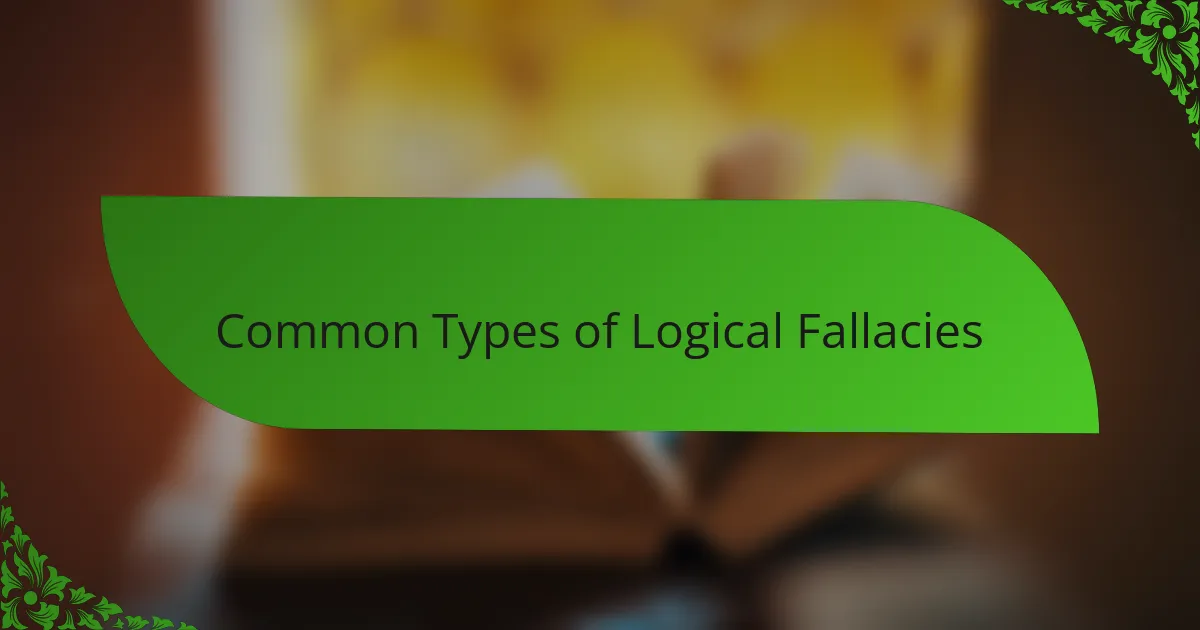
Common Types of Logical Fallacies
One of the most common logical fallacies I’ve bumped into is the ad hominem, where instead of addressing the argument, the focus shifts to attacking the person making it. It’s baffling how often this sneaky tactic sneaks into discussions, especially online, and I find myself catching my own thoughts before slipping into it. Have you noticed how easy it is to get distracted by who says something rather than what they’re actually saying?
Another fallacy I wrestled with early on was the false dilemma, which frames complex issues as if only two choices exist. When I first spotted this in a heated debate, it felt like a breath of fresh air—because suddenly, alternatives that I hadn’t even considered became visible. Isn’t it frustrating how oversimplification can shut down meaningful dialogue so quickly?
Then there’s the slippery slope fallacy, which suggests that one small step will inevitably lead to a chain of disastrous events. I’ve caught myself worrying about this kind of reasoning during personal decisions, realizing later that I might have exaggerated the consequences. Have you ever found your mind racing down that slippery path, only to pause and rethink what’s actually likely to happen?
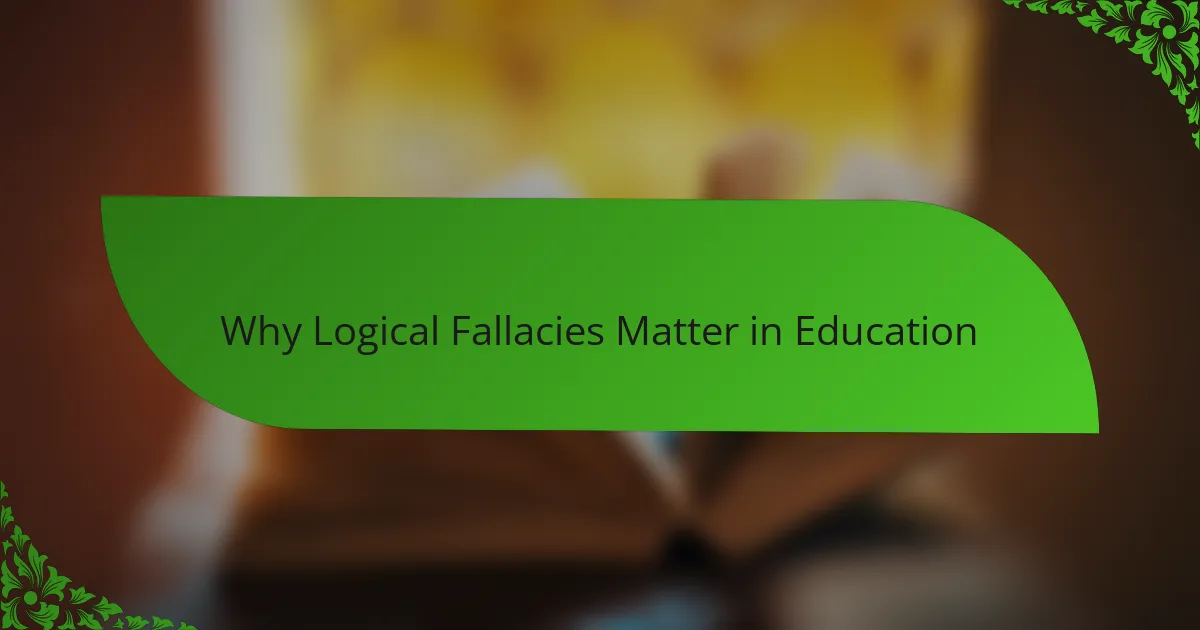
Why Logical Fallacies Matter in Education
When I reflect on why logical fallacies matter so much in education, it’s clear to me that they shape how we learn to think, not just what we think. Have you ever sat through a lecture or read an article where the argument felt convincing but something didn’t quite add up? That unsettling feeling often comes from hidden fallacies, which can mislead students and stunt genuine understanding.
In my experience, spotting these fallacies early helps build a mindset of vigilance and curiosity. It’s like training your brain to be a detective, always questioning and verifying claims rather than accepting them at face value. This skill doesn’t just improve philosophy studies—it’s essential for navigating everyday information flood, from news to conversations.
I’ve noticed that when educators emphasize logical fallacies, students gain confidence to challenge ideas respectfully and thoughtfully. Imagine how much richer classroom discussions become when everyone learns to identify weak reasoning without jumping to dismiss others. Isn’t that the kind of critical engagement education should foster?
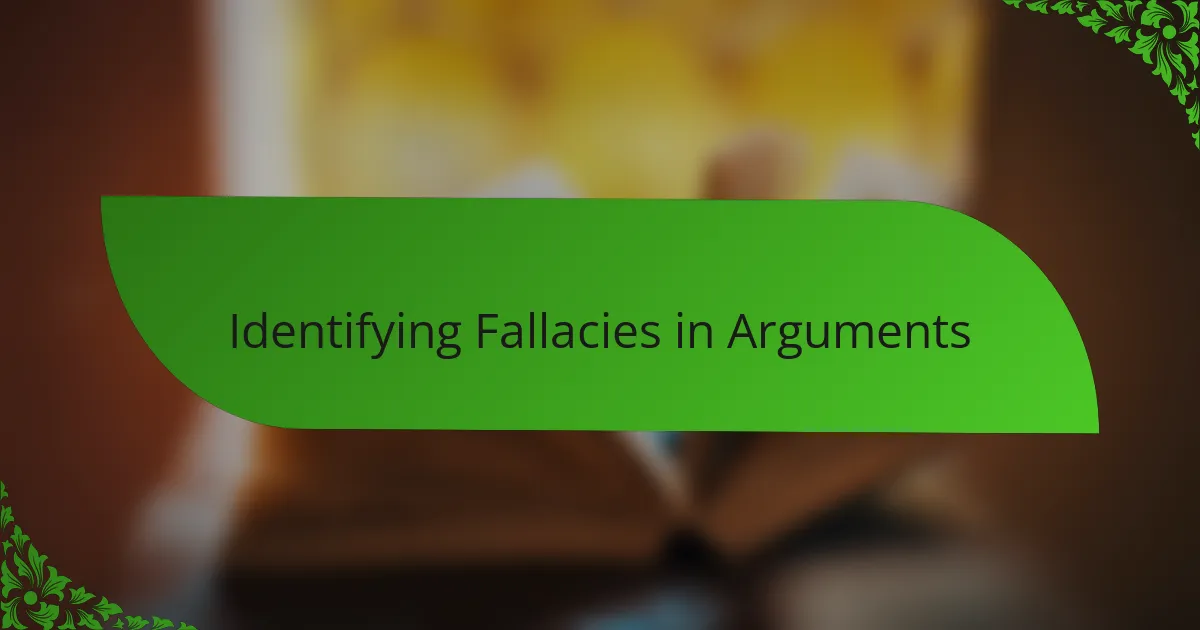
Identifying Fallacies in Arguments
Spotting fallacies in arguments often feels like unraveling a puzzle. I remember dissecting a debate and catching a subtle appeal to authority—where someone leaned too heavily on a supposed expert’s opinion without solid evidence. Have you ever noticed how this can make an argument sound airtight, even when the reasoning is shaky beneath the surface?
What helps me most is slowing down and asking, “Does this claim really follow from the evidence, or is something being twisted?” Early on, I would rush through arguments, missing those hidden traps. Now, I find that pausing to question motives and logic reveals fallacies that initially slip past unnoticed.
Sometimes, I catch myself using fallacies without realizing it, which is a humbling reminder that no one is immune. Identifying them in others becomes a tool for self-checking, pushing me to think more honestly and clearly. Don’t you think this ongoing vigilance is what sharpens our reasoning over time?

My Experience Applying Logical Fallacies
Applying logical fallacies myself was a surprising journey—I quickly learned how easy it is to fall into these traps, especially when emotions run high. I recall one argument where I used a straw man without even noticing; later, realizing how unfairly I had misrepresented the other person’s position made me feel a mix of embarrassment and determination to do better. Have you ever caught yourself twisting someone’s words just to make your point stronger? It’s more common than we think.
What struck me most was how using fallacies sometimes gave a fleeting sense of winning, but underneath, there was a gnawing discomfort. It’s like taking a shortcut that feels good momentarily but leaves you questioning the integrity of your reasoning afterward. This conflicting feeling pushed me to reflect deeply on why I was leaning on faulty logic and how that reflected on my commitment to honest discussion.
Over time, deliberately trying to avoid fallacies transformed my approach—not just to arguments, but to everyday conversations. I started asking myself, “Am I really addressing the issue, or am I just trying to score a point?” This constant self-checking became a personal practice that I find invaluable, especially when navigating complex or heated debates. Wouldn’t you agree that truly understanding fallacies means not just spotting them in others, but wrestling with them inside ourselves?
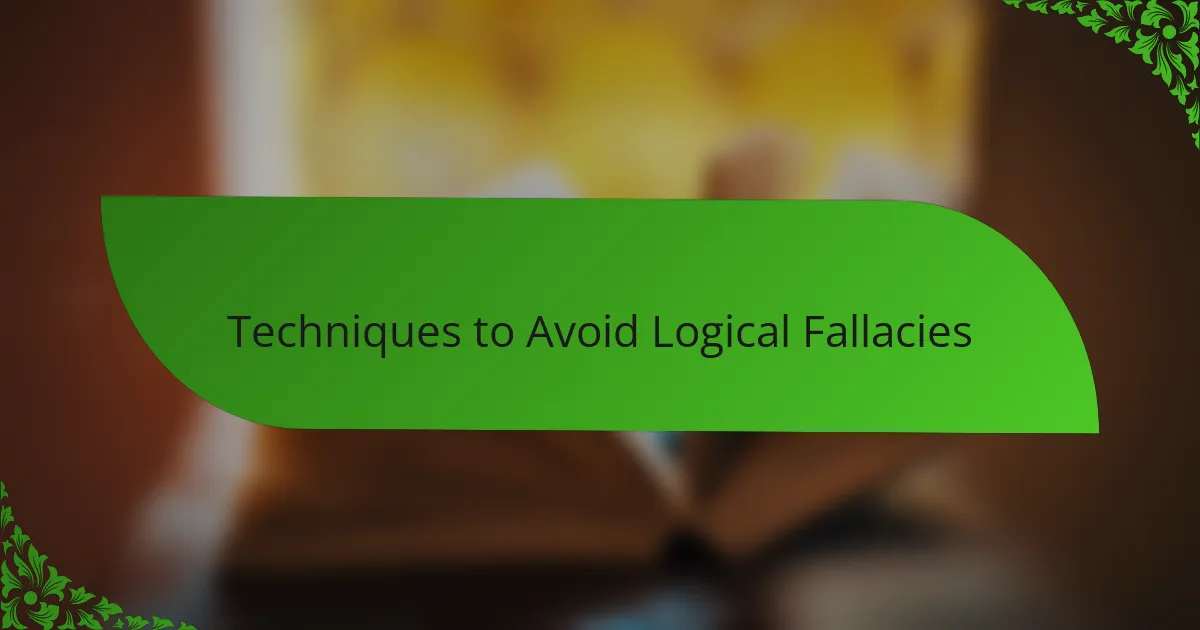
Techniques to Avoid Logical Fallacies
One technique I’ve found invaluable is slowing down the pace of my thinking. When I catch myself rushing to respond, that’s usually when fallacies sneak in unnoticed. Have you ever jumped into a debate only to realize later that your argument didn’t really connect? Taking a moment to pause and reflect can be a game-changer.
Another approach that’s helped me tremendously is actively asking for clarification. When someone’s argument feels off, instead of assuming it’s wrong, I try to pinpoint exactly where the reasoning breaks down by asking questions like, “What evidence supports this?” or “Are there other possibilities here?” This habit not only sharpens your understanding but also keeps the conversation respectful and insightful.
Finally, I embrace the practice of self-monitoring my thoughts and arguments. It’s easy to slip into using fallacies, especially when emotions flare. Catching myself before I resort to a straw man or false dilemma takes honesty and discipline. Isn’t it intriguing how much clearer discussions become when you commit to this kind of internal accountability? Over time, avoiding these traps turns from a chore into a natural part of how I think.
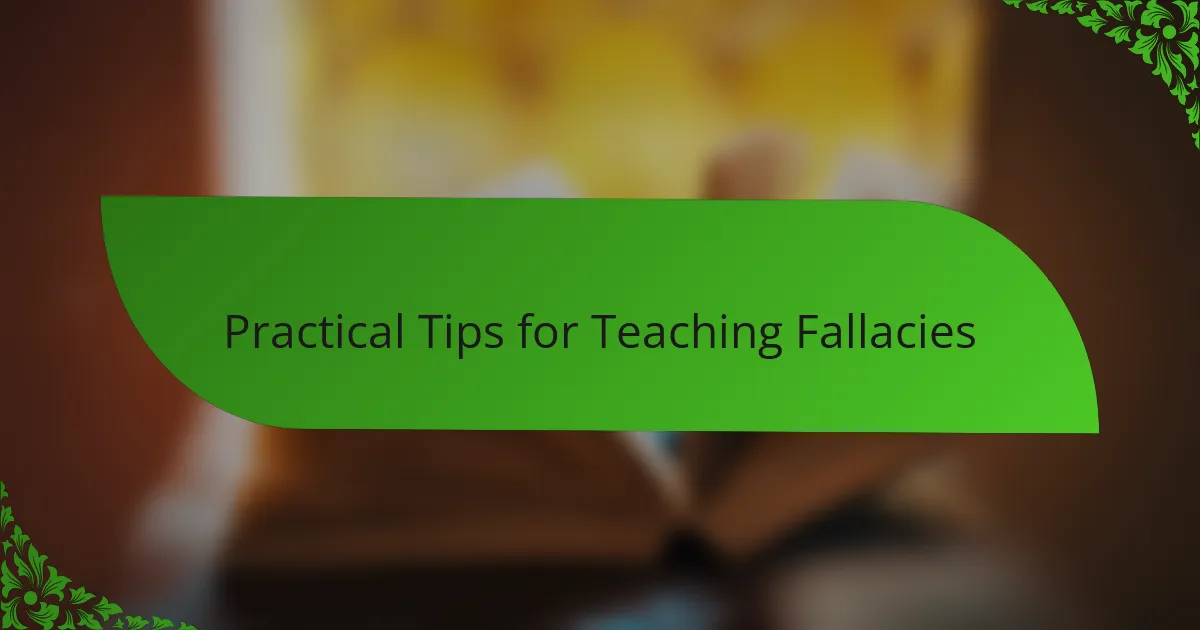
Practical Tips for Teaching Fallacies
When I first started teaching fallacies, I found that using real-life examples sparked the most engagement. For instance, sharing a heated social media argument where a straw man popped up helped students see fallacies not as dry concepts but as everyday pitfalls. Doesn’t it make a difference when you realize these errors happen to all of us, not just in textbooks?
I’ve also noticed that inviting students to play “fallacy detective” in their own conversations creates a lively atmosphere. Encouraging them to cheer each other on when spotting errors shifts the focus from judgment to curiosity. How often do you think we miss these teachable moments simply because we’re not looking for them actively?
Lastly, mixing in short debates or role-plays where students intentionally use and then identify fallacies has been a game changer for me. It can feel awkward at first, but seeing their surprise when peers call out a false dilemma or an ad hominem in real-time really cements the learning. Isn’t it fascinating how practicing mistakes can actually make you a stronger thinker?